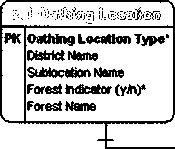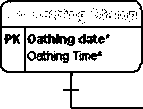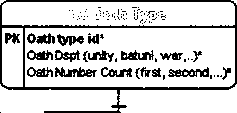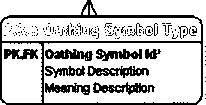The Mau Mau Oath Model
Figure 1.0 The Mau Mau Oath Model,
1952-1960



New Mau Mau Relationships Created by
the 1950s
Gender Oathing Role Type
Mau Mau Role Description
M Eiaoa Mata (Sθ⅛
PK
OaThing Rote Id'
AdministratorName
Addtl Parttcpt Name Desdptn
OatherName*

PK Oatldng Symbol Id’
SymboIIcMeaning Description
PK
PK,FK
PKeFK
PIGFK
PK
PK
PKeFK
PIGFK
PKJsK
Odllt id'
OMhing Location Type'
OMhing dale*
Oadthig Role M,
Oaliiing Symbol Type*
Oattting Statement Id1
Oathing Symbol Id*
Oathtypeid1
Young indicator*
Purfication Date
■|— District Name
Administered By Name
Chief Indicator (yJh)
Church Name Description
Church Indicator (y∕h)

Arrest Date
District Name
Arresting Officer Name
Criminal Offense Description
Court Case Number
Appeal Indicator (y∕h)
Appeal Date
Court Name
Judge Name
Court Ruling Description

PIGFK
PIGFK
PKyFK
PIGFK
PK,FK
PK,FK
PIGFK
PKJFK
Oathing Statement id*
Statement Description
Meaning Description
OMh id’
Oathhtg Location Type*
Oathing date*
Oathing Role M*
Oalhhtg Symbol Type*
Oathhig Symbol kt*
Oathtype id*
PKJFK Young indicator*
Young indicator*
age
The Mau Mau oath was a dynamic, elaborate, and sophisticated system of
relationships, rules, and structures. Through the depiction of the created “Mau
Mau Oath Model”, represented as Figure 1.0, this section aims to walk through
the complexity of the oathing by examining the relationship between the oath and
other oathing related variables within the scope of this research. Unfortunately,
this model is not able to capture every nuance of the oathing experience, but it is
designed in a manner that will allow a careful treatment and analysis of the key
79
More intriguing information
1. Education and Development: The Issues and the Evidence2. Cyclical Changes in Short-Run Earnings Mobility in Canada, 1982-1996
3. The name is absent
4. The name is absent
5. Determinants of U.S. Textile and Apparel Import Trade
6. Perfect Regular Equilibrium
7. Eigentumsrechtliche Dezentralisierung und institutioneller Wettbewerb
8. The Making of Cultural Policy: A European Perspective
9. Place of Work and Place of Residence: Informal Hiring Networks and Labor Market Outcomes
10. Tourism in Rural Areas and Regional Development Planning